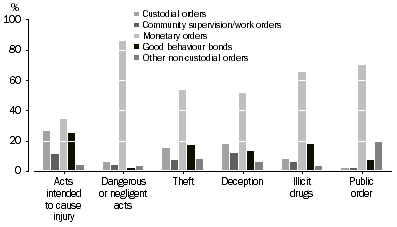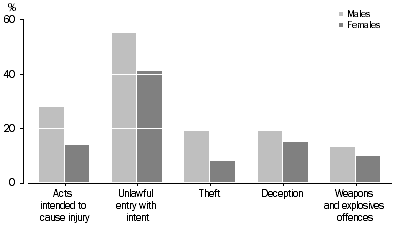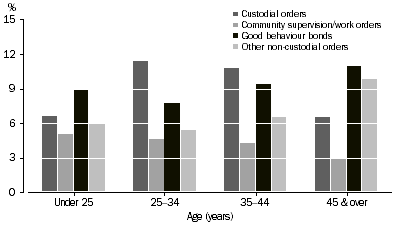SENTENCE OUTCOMES
In 2006-07, the majority (95% or 501,955) of defendants tried in the Magistrates' Courts were proven guilty, with the remaining 5% acquitted of all charges. Of those charged with illicit drug offences and dangerous or negligent acts, almost all (99%) were proven guilty.
The following information relates to sentence outcomes for defendants proven guilty. Defendants are referred to as 'convicted' where they were proven guilty of at least one of the final charges laid against them.
Principal sentence
Data on sentences are collected for all defendants proven guilty of one or more charges in the criminal courts. Sentence refers to the principal sentence a defendant received which is usually, though not necessarily, the sentence associated with the principal offence. See Explanatory Notes paragraph 42 for further information.
The most serious penalties issued for charges proven in the Magistrates' Courts are custodial sentences. In 2006-07, 9% (42,721) of convicted defendants had custodial orders imposed; 4% sentenced to custody in a correctional institution, 4% given fully suspended sentences and 1% sentenced to custody in the community.
Defendants convicted of road traffic offences and acts intended to cause injury comprised 23% each of all defendants given custodial sentences. Defendants convicted of theft accounted for a further 10% of custodial sentences.
The majority of convicted defendants (91%) were given non-custodial sentences (i.e. community supervision or work orders, monetary orders, good behaviour bonds or other non-custodial sentences).
The most common non-custodial sentence was a monetary order, with 72% of defendants proven guilty receiving this sentence. Monetary orders were most common for offences of dangerous or negligent acts endangering persons and road traffic offences (86% and 84% of defendants convicted of these offences respectively).
DEFENDANTS PROVEN GUILTY, Selected principal offence by selected principal sentence

Sex
While monetary orders were an equally likely sentence for both convicted males and females (72% each), males proven guilty were twice as likely to receive a custodial sentence (10%) than females (5%). The higher proportion of custodial sentences for males was consistent across all principal offences. Custodial orders were issued to 55% of males proven guilty of unlawful entry with intent while the same sentence was given to 41% of females convicted of this offence. Custodial orders were also issued to 28% of males proven guilty of acts intended to cause injury. In contrast, 14% of females convicted of this offence were issued with custodial orders. These differences may be associated with a range of aggravating and mitigating factors taken into account by the court, such as prior convictions, level of violence, whether the offender was provoked, and demonstrations of remorse.
DEFENDANTS PROVEN GUILTY, Proportion sentenced to custodial orders by selected principal offence and sex

Age
While monetary orders were consistently the most common sentence handed out across all age groups there were some differences in other sentence types. Convicted defendants aged 25 to 34 years and 35 to 44 years were more likely to receive a custodial order than a good behaviour bond, while defendants aged under 25 years, and 45 years and over, were more likely to receive a good behaviour bond than a custodial order.
DEFENDANTS PROVEN GUILTY, Age groups by selected principal sentences

 Print Page
Print Page
 Print All
Print All